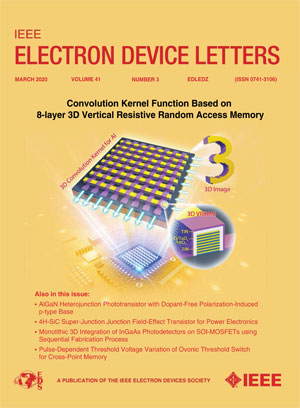Photolithographic PEDOT:PSS Electrodes for Transparent and Conformal Organic Transistors
IF 4.1
2区 工程技术
Q2 ENGINEERING, ELECTRICAL & ELECTRONIC
引用次数: 0
Abstract
Poly(3,4-ethylenedioxythiophene):poly (styrenesulfonate) (PEDOT:PSS) is widely used as electrode material for transparent and conformal organic thin-film transistors (TC-OTFTs) owing to its excellent conductivity, high transparency, and good mechanical flexibility. However, due to the lack of high-precision and high-density transparent flexible electrodes, the high-level integration of TC-OTFTs faces a huge challenge. Here, we propose a simple protective layer photolithography strategy that successfully achieves non-destructive photolithography of PEDOT:PSS. The pattern feature size is down to 750 nm, which is the smallest size of PEDOT:PSS reported so far. Based on such high-precision transparent electrodes, we successfully fabricate TC-OTFTs with a device density up to 50,020 transistors光刻PEDOT:用于透明和共形有机晶体管的PSS电极
聚(3,4-乙烯二氧噻吩):聚(苯乙烯磺酸盐)(PEDOT:PSS)由于其优异的导电性、高透明度和良好的机械柔韧性,被广泛用作透明和保形有机薄膜晶体管(TC-OTFTs)的电极材料。然而,由于缺乏高精度、高密度的透明柔性电极,TC-OTFTs的高水平集成面临着巨大的挑战。本文提出了一种简单的保护层光刻策略,成功实现了PEDOT:PSS的无损光刻。该模式特征尺寸降至750nm,是迄今为止报道的最小的PEDOT:PSS尺寸。基于这种高精度透明电极,我们成功制造出器件密度高达50020个晶体管的tc - otft ${\text{cm}}^{-{2}}$,这是目前报道的tc - otft的最大值。更引人注目的是,该设备展示了1.51 cm2的出色迁移率${\text{V}}^{-{1}} {\text{s}}^{-{1}}$。这项工作为实现tc - otft的可扩展制造和高密度集成提供了可靠的光刻策略,为开发具有高密度和高性能的可穿戴隐形电子产品提供了巨大的潜力。
本文章由计算机程序翻译,如有差异,请以英文原文为准。
求助全文
约1分钟内获得全文
求助全文
来源期刊

IEEE Electron Device Letters
工程技术-工程:电子与电气
CiteScore
8.20
自引率
10.20%
发文量
551
审稿时长
1.4 months
期刊介绍:
IEEE Electron Device Letters publishes original and significant contributions relating to the theory, modeling, design, performance and reliability of electron and ion integrated circuit devices and interconnects, involving insulators, metals, organic materials, micro-plasmas, semiconductors, quantum-effect structures, vacuum devices, and emerging materials with applications in bioelectronics, biomedical electronics, computation, communications, displays, microelectromechanics, imaging, micro-actuators, nanoelectronics, optoelectronics, photovoltaics, power ICs and micro-sensors.
 求助内容:
求助内容: 应助结果提醒方式:
应助结果提醒方式:


